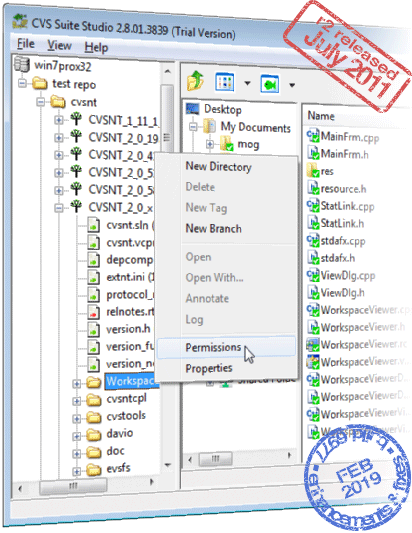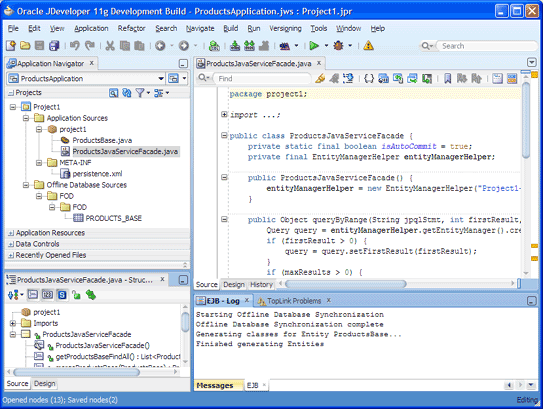Rob Clevenger from the JDev team demoed the gorgeous JDeveloper 10g-on-Mac OS X UI for me yesterday in the DEMOgrounds (look for Pod F19). Starting with 10.1.2 (the production release is imminent), JDev will be certified and supported on OS X. How-To: Installing JDeveloper on Your Mac Posted by Jake Posted 8 years ago 12 April 2012 Although some people don’t agree, I think there’s value in reposting technical tips for a few reasons.
This chapter describes how to install the Oracle JDeveloper Studio software.


This chapter contains the following sections:
2.1 Understanding the Oracle JDeveloper Installation Types
Before you run the generic installer, ensure that the following prerequisites are met:

You must have the required JDK installed on your system. You can obtain the specific version of JDK from the following location on OTN:
http://www.oracle.com/technetwork/java/javase/downloads/index.html.To streamline your installation process, the JDK you wish to use with the product should be the one you use to start the installer program. In that case, be sure the desired JDK is the first one in your system
PATH, or reference it explicitly on the command line.Note:
The JDK version specific to the Oracle JDeveloper installation is installed automatically when you use the platform-specific installer.
2.2 Installing Oracle JDeveloper Studio on Various Platforms
This section describes how to install Oracle JDeveloper Studio on various platforms.
It contains the following topics:
2.2.1 Starting the Installation Program
Depending on the type of installer you are using, you can begin the installation program in one of the following ways:
Launching the Generic Installer on Linux or UNIX Systems
To launch the platform-independent installer on your hosted Linux or UNIX machine, follow these steps:
Log in to the host computer where you want to install Oracle JDeveloper.
Be sure the user account you use for installing Oracle JDeveloper has the required privileges. For more information, see 'Selecting an Installation User' in Planning an Installation of Oracle Fusion Middleware.
Ensure that a certified JDK exists on the system on which you are about to install Oracle JDeveloper.
For more information, see the appropriate certification document for 12c (12.1.2) on the Oracle Fusion Middleware Supported System Configurations page.
Go to the directory where you downloaded the installation program.
Launch the installation program by invoking
java -jarfrom the JDK directory on your system, as shown in the example below:For example:
Be sure to replace
/home/Oracle/jdk7_15/jdk1.7.0_15in this example with the location of the JDK on your system.
When the installation program appears, you are ready to begin the installation. See Section 2.2.2 for a description of each installation program screen.

Launching the Generic Installer on Windows
To launch the platform-independent installer on your Windows machine, do the following:
Log in to the host computer where you want to install Oracle JDeveloper.
Be sure the user account you use for installing Oracle JDeveloper has the required privileges. For more information, see 'Selecting an Installation User' in Planning an Installation of Oracle Fusion Middleware.
Ensure that a certified JDK exists on the system on which you are about to install Oracle JDeveloper. For more information, see the appropriate certification document for 12c (12.1.2) on the Oracle Fusion Middleware Supported System Configurations page.
Using command prompt, navigate to the directory where you downloaded the installation program.
Launch the installation program by invoking
java -jarfrom the JDK directory on your system, as shown in the example below:For example:
Be sure to replace
homeOraclejdk7_15jdk1.7.0_15in this example with the location of the JDK on your system.
When the installation program appears, you are ready to begin the installation. See Section 2.2.2 for a description of each installation program screen.
Launching the Generic Installer on Mac OS
To launch the platform-independent installer on your Mac OS, follow the instructions listed in 'Launching the Generic Installer on Linux or UNIX Systems'.
Launching the Platform-Specific Installer
To launch the platform-specific installer on Linux, follow these steps:
Log in to the host computer where you want to install Oracle JDeveloper.
Be sure the user account you use for installing Oracle JDeveloper has the required privileges. For more information, see 'Selecting an Installation User' in Planning an Installation of Oracle Fusion Middleware.
Navigate to the location where the platform-specific installer is located.
Launch the installer by running the following command:
To launch the platform-specific installer on Windows, follow these steps:
Log in to the host computer where you want to install Oracle JDeveloper.
Be sure the user account you use for installing Oracle JDeveloper has the required privileges. For more information, see 'Selecting an Installation User' in Planning an Installation of Oracle Fusion Middleware.
Using the command prompt, navigate to the location where the platform-specific installer is located.
Launch the installer by running the following command:
When the installation program appears, you are ready to begin the installation. See Section 2.2.2 for a description of each installation program screen.
You can also launch the installer in silent mode to ensure that no configuration options are displayed during the installation process. For more information, see Section A.1, 'Installing Oracle JDeveloper Studio in Silent Mode'.
2.2.2 Navigating the Installation Screens to Install Oracle JDeveloper
The installation program displays a series of screens, in the order listed in Table 2-1.
If you need additional help with any of the installation screens, click the screen name.
Table 2-1 Oracle JDeveloper Install Screens
| Screen | Description |
|---|---|
This screen appears if this is the first time you are installing any Oracle product on this host. Specify the location where you want to create your central inventory. Make sure that the operating system group name selected on this screen has write permissions to the central inventory location.For more information about the central inventory, see 'Understanding the Oracle Central Inventory' in Installing Software with the Oracle Universal Installer. | |
This screen introduces you to the product installer. | |
Use this screen to specify the location of your Oracle home directory. Ensure that the name of the directory that you choose does not contain spaces. For more information about Oracle Fusion Middleware directory structure, see 'Selecting Directories for Installation and Configuration' in Planning an Installation of Oracle Fusion Middleware. | |
This screen verifies that your system meets the minimum necessary requirements. If there are any warning or error messages, refer to Section 1.4. | |
Use this screen to verify the installation options you selected. If you want to save these options to a response file, click Save and provide the location and name of the response file. Response files can be used later in a silent installation situation. For more information about silent or command line installation, see 'Using the Oracle Universal Installer in Silent Mode' in Installing Software with the Oracle Universal Installer. | |
This screen allows you to see the progress of the installation. | |
This screen appears when the installation is complete. Review the information on this screen. You can use this screen to customize Oracle JDevleoper. For more information about customizing Oracle JDeveloper using the Installation Completed screen, see Section 2.2.3. |
For more information about the installation screens that appear while installing Oracle Jdeveloper, see 'Oracle Fusion Middleware Infrastructure Installation Screens' in Installing with Oracle Universal Installer.
2.2.3 Customizing Oracle JDeveloper on Startup
On completing the installation, the installer displays a list of options that you can use to proceed with the product that you have installed. You can customize Oracle JDeveloper using the options listed on the Installation Complete screen of the installer. See Figure 2-1.
Figure 2-1 Options to Customize Oracle JDeveloper Installer

Download Jdeveloper For Mac
Description of 'Figure 2-1 Options to Customize Oracle JDeveloper Installer'
To customize Oracle JDeveloper using the installation wizard, select one of the options listed in the Next Steps section of the Installation Complete screen. Table 2-2 describes the options that you see on the Installation Complete screen of the wizard:
Table 2-2 Options to Customize Oracle JDeveloper on Startup
| Option | Description and Action |
|---|---|
Start JDeveloper with Default Settings | Select this option if you want to start Oracle JDeveloper using the default settings. All your Oracle JDeveloper projects will be saved in this default location. |
Customize Settings and Then Start JDeveloper | Select this option to do the following:
|
Finish Installation without Starting JDeveloper | Select this option to quit the installation wizard without starting Oracle JDeveloper. |
Note:
If you are reinstalling the same version of Oracle JDeveloper after deinstalling it, the system directory from the previous installation, gets associated with the new installation by default. Therefore, to reinstall the same version of Oracle JDeveloper, you must either delete the previously created system directory first, or set a new user home directory after reinstallation, as described in Section 3.6, 'Setting the User Home Directory'.
On Windows systems, if you are deinstalling your current version of Oracle JDeveloper to install a newer version, Oracle recommends that you reboot your system after you deinstall the software, and before you begin a new installation of the software.
2.3 Verifying Your Installation
To verify that your installation was completed successfully, you can compare your directory structure to the one described in Table 2-3.
Jdeveloper For Oaf
Table 2-3 describes the directory structure that will be created on your system at the end of your Oracle JDeveloper installation.
Table 2-3 Directory Description for Oracle JDeveloper Home
| Directory or File | Description |
|---|---|
JDeveloper Home | This directory is the Oracle home that contains the binary files and configuration files that are required to run Oracle JDeveloper. |
| This directory contains the log files for your installation and configuration transactions. |
| This directory contains the Coherence product files. |
| This directory contains files used by Oracle Enterprise Manager Fusion Middleware Control. |
| This directory contains information about the components, feature sets, and patches installed in this Oracle JDeveloper home directory. |
| This file is located in the |
| This directory contains the files that are needed to run the Oracle JDeveloper application. It also contains files that can be used to modify the application settings. |
| This directory contains OPatch and supported files. OPatch is a tool used to patch Oracle Fusion Middleware software. |
| This directory contains the binary and library files required for Oracle Enterprise Manager Fusion Middleware Control and Java Required Files (JRF). |
| This file contains information about the inventory location of the installation. |
| This directory contains files used by the Oracle Universal Installer, including the deinstaller program. If you need to run the Oracle Universal Installer again after the product is installed, you should do so from this directory. |
| This directory contains the WebLogic Server product files. |
Jdeveloper Download For Mac
2.4 Installing the JDeveloper Java Edition
The JDeveloper Java Edition does not require an installer. To install Oracle JDeveloper Java, you need an unzip tool. You can download a free, cross-platform unzip tool, Info-Zip, available at: http://www.info-zip.org/.
Caution:
Jdeveloper For Adf
Ensure that the directory that you install Oracle JDeveloper in, does not contain spaces. For example, do not use C:Program Files as the installation directory.
To install JDeveloper from jdevjava.zip:
Obtain the required JDK from:
http://www.oracle.com/technetwork/java/javase/downloads/index.html.Unzip
jdevjava.zipto the target directory.Note:
In this document, in the context of the Java Edition,
JDEV_HOMEis used to represent the directory of the installation. For example, if you unzippedjdevjava.zipintoC:jdev_install, thenJDEV_HOMErefers toC:jdev_install.
